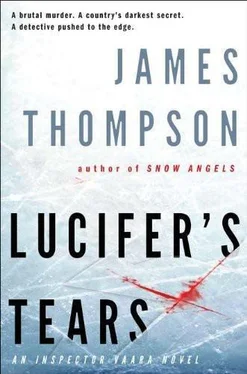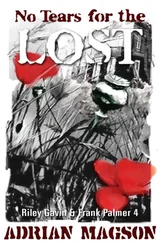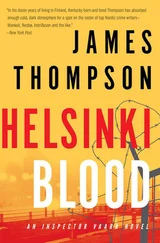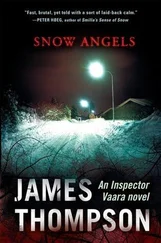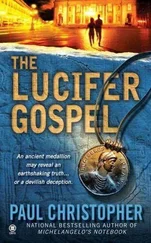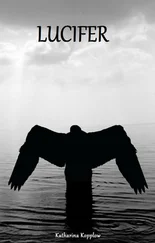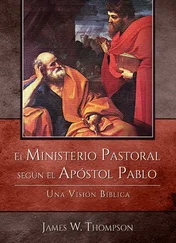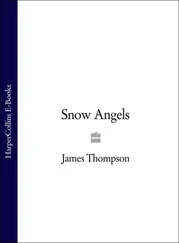James Thompson - Lucifer's tears
Здесь есть возможность читать онлайн «James Thompson - Lucifer's tears» — ознакомительный отрывок электронной книги совершенно бесплатно, а после прочтения отрывка купить полную версию. В некоторых случаях можно слушать аудио, скачать через торрент в формате fb2 и присутствует краткое содержание. Жанр: Полицейский детектив, на английском языке. Описание произведения, (предисловие) а так же отзывы посетителей доступны на портале библиотеки ЛибКат.
- Название:Lucifer's tears
- Автор:
- Жанр:
- Год:неизвестен
- ISBN:нет данных
- Рейтинг книги:5 / 5. Голосов: 1
-
Избранное:Добавить в избранное
- Отзывы:
-
Ваша оценка:
- 100
- 1
- 2
- 3
- 4
- 5
Lucifer's tears: краткое содержание, описание и аннотация
Предлагаем к чтению аннотацию, описание, краткое содержание или предисловие (зависит от того, что написал сам автор книги «Lucifer's tears»). Если вы не нашли необходимую информацию о книге — напишите в комментариях, мы постараемся отыскать её.
Lucifer's tears — читать онлайн ознакомительный отрывок
Ниже представлен текст книги, разбитый по страницам. Система сохранения места последней прочитанной страницы, позволяет с удобством читать онлайн бесплатно книгу «Lucifer's tears», без необходимости каждый раз заново искать на чём Вы остановились. Поставьте закладку, и сможете в любой момент перейти на страницу, на которой закончили чтение.
Интервал:
Закладка:
“So you have a vested personal interest in your investigation.”
“Yes.”
“I don’t know more about Toivo Kivipuro either, but I think what you’re really asking me is if the Finns stationed in Stalag 309 took part in the Holocaust. The answer is yes. In terms of scale, Finland’s participation was minuscule. In my opinion, though, any part in the Holocaust is unacceptable and punishable. Whether the detectives there killed men themselves or not, they colluded in the decision-making process of who would die.”
Not what I wanted to hear. The truth of it unsettles me. “Where can I research this myself?”
“Many of the Valpo records are where they’ve always been, in Ratakatu 12. It was then and is now security police headquarters, but historians are allowed to search records up through the year 1948. I’m going there this afternoon to do research for a new book. You’re welcome to join me. Get permission to visit and have them pull the files for you.”
We agree to meet in an hour.
“Bring a pen and notepad,” Pasi says. “They don’t allow cameras or photocopying.” He hangs up.
I call Jyri and tell him to get permission for me. I need to see the Valpo files, but I don’t want to. The Bible tells us that the truth will set us free. I reflect that Jesus must have been unclear about certain of life’s realities.
23
I find Pasi Tervomaa waiting for me in front of SUPO headquarters. We recognize each other but haven’t met. He’s a regular at Kotiharjun sauna. He’s fortyish, thin and gaunt, but his smile reflects warmth. He waits while I finish a cigarette. The building is fortresslike granite block, gray and yellow, reminds me of pictures I’ve seen of the Lubyanka-KGB headquarters, former Soviet prison and charnel house-only smaller and less ornate. In fact, SUPO, as was Valpo before it, is Finland’s version of the KGB. They deal in counterespionage, counterterrorism, prevention of threats to internal security and related matters.
“Your inquiry is an interesting confluence,” Pasi says. “I’m also researching a so-called war criminal. Lauri Torni.”
I know about Torni. He fought for Finland, then for Germany in the Waffen-SS, and finally for the Americans. He changed his name to Larry A. Thorn, joined the Green Berets and died in a helicopter crash in Laos in 1965, while on a covert mission.
We go inside. A custodian type meets us and checks our IDs. He has the files Pasi requested ready for us and escorts us to a jail cell in the basement. It only contains a wooden table with a reading lamp on it, and a couple of chairs. The custodian sets our files on the table and leaves.
I think of the Lubyanka again. “Did Valpo torture enemies of the state in this cell?” I ask.
“No,” Pasi says, “they did that in the interrogation rooms.”
“I was only half serious. I can’t picture Finnish police torturing anyone.”
“Don’t be naive. Of course they did. In general, not as brutally as the Nazis or Soviets, but interrogations sometimes employed physical coercion. Beatings. Hitting the soles of the feet with nightsticks. Things like that.”
We sit. He hands me files on Arvid and Ukki. “Let’s take a look,” he says.
The dossiers are thin. I open Arvid’s first. Pasi and I read it together. The photo clipped to it is nearly seventy years old, but it’s Arvid. The top sheet gives vital stats.
DOB: January 3, 1920. Arvid enters Valpo service in 1938, at age eighteen, is stationed in Helsinki. I wonder how he got into the security police at such a young age. By 1940, he receives two citations for distinction in service. Reasons not stated.
He’s fluent in German and Russian. He leaves Valpo service for a time to go to the front during the Winter War. He’s wounded in action. After recovery, he goes back to work for Valpo, this time up north, in the Rovaniemi station. In 1941, he’s attached to Einsatzkommando Finnland. The sheet states only Salla. No mention of a stalag. In January 1943, he’s again stationed in Helsinki. He’s fired by Valpo in June 1945. I ask Pasi why this might have been.
“Anti-Communist White Valpo was replaced by Red Valpo, Communists and leftist radicals. The new security police were by and large men that the old security police once investigated. Out with the old and in with the new.”
Arvid’s sheet details his commendations and medals. The Mannerheim Cross-the medal of honor. The Commemorative Medal of the Winter War. The Badge for Wounded Veterans. The Nordfront Crosses-awarded by Germany. The Order of the Cross of Liberty. The Order of the White Rose of Finland. The Order of the Lion of Finland. The list goes on.
The last page of the dossier is a letter of recommendation dated August 12, 1938. The writer is Bruno Aaltonen, deputy director of Valpo. He requests that Arvid be accepted into Valpo service forthwith.
“Arvid Lahtinen was connected to people high up in the intelligence community,” Pasi says. “Aaltonen took such matters seriously and wouldn’t have taken Lahtinen into Valpo unless he had the highest confidence that he was detective material.”
I open Ukki’s dossier. In his photo, he’s nineteen years old. Ukki was a year older, but other than that, their files are nearly identical. Ukki and Arvid entered Valpo service at the same time, worked in the same duty stations during the same time frames, won almost all the same medals. Everything. The last page is a recommendation from Bruno Aaltonen that Toivo Kivipuro be taken into the security police as a detective. The date: August 12, 1938. It’s like reading about twin brothers.
“Arvid lied,” I say. “He told me he didn’t know my grandpa.”
“Given that they were so young, and Aaltonen wrote the letters on the same day, there must be a connection between your family and Arvid’s. My guess is that Aaltonen knew their fathers, and together, they asked Aaltonen for their appointments. That also might explain their assignment to Einsatzkommando Finnland.”
“How so?”
“Aaltonen was acquainted with the Gestapo hierarchy, all the way up to Reinhard Heydrich, chief of the Reich Security Office, who formed Einsatzkommando. Aaltonen was also a friend of Heinrich Muller, the head of the Gestapo. They engaged in extensive correspondence. Dozens of their letters have been preserved. The letters discuss family and work issues as well as politics. These kinds of personal ties became the basis for collaboration between German and Finnish officials. Arvid Lahtinen and Toivo Kivipuro were likely given their positions at Stalag 309 because their families were highly regarded and trusted.”
I know nothing about my great-grandfather, not even his name. “You’re certain Arvid and my grandpa were at the stalag? Without a doubt?”
“I’m a historian, an academic. I seldom state that anything is without doubt unless I’ve seen it with my own eyes, and I wasn’t there. But let’s call it a ninety-nine percent certainty that Arvid Lahtinen lied to you.”
“Can you make a reasonable guess about what Arvid and Grandpa did there?”
“Well, Einsatzkommando Finnland was mandated to liquidate Jews and Soviet political commissars. These are the people Arvid and Toivo worked with. Let’s just say that I think the verve and enthusiasm of Einsatzkommando might have been infectious. I gather the Finnish detectives and interpreters there often drank heavily. It’s easy to picture them getting drunk and doing things they never would have dreamed themselves capable of.”
“You’re saying Finns lined people up and shot them.”
“I can’t say that. I can say that, given the atmosphere, it seems likely.”
He’s saying in that prevaricating way, typical of academics, that Arvid and Ukki were stone-cold killers. I’ve barely started this investigation, and I’m already discovering things that, four days ago, would have been beyond my comprehension. “How in the hell could this have remained secret for so long?”
Читать дальшеИнтервал:
Закладка:
Похожие книги на «Lucifer's tears»
Представляем Вашему вниманию похожие книги на «Lucifer's tears» списком для выбора. Мы отобрали схожую по названию и смыслу литературу в надежде предоставить читателям больше вариантов отыскать новые, интересные, ещё непрочитанные произведения.
Обсуждение, отзывы о книге «Lucifer's tears» и просто собственные мнения читателей. Оставьте ваши комментарии, напишите, что Вы думаете о произведении, его смысле или главных героях. Укажите что конкретно понравилось, а что нет, и почему Вы так считаете.
